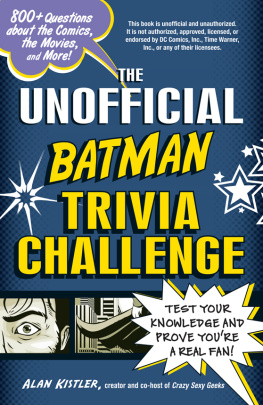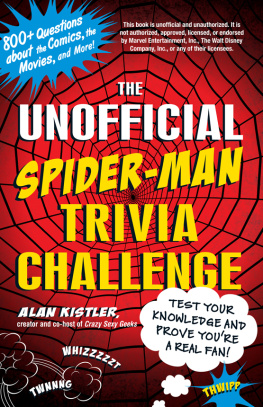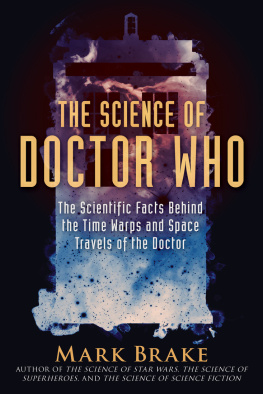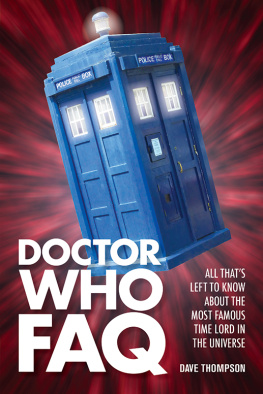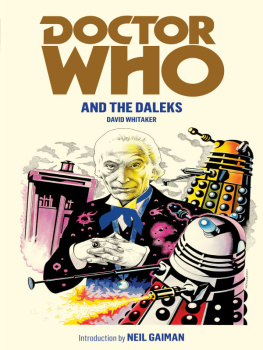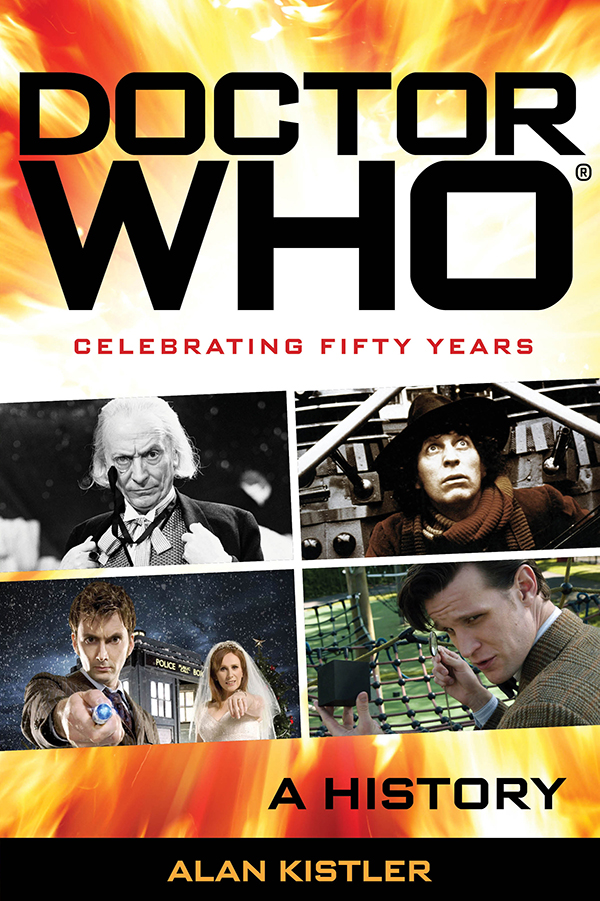DOCTOR
WHO
A HISTORY
Alan Kistler
LYONS PRESS
Guilford, Connecticut
An imprint of Globe Pequot Press
Copyright 2013 by Alan Kistler
All rights reserved. No part of this book may be reproduced or transmitted in any form by any means, electronic or mechanical, including photocopying and recording, or by any information storage and retrieval system, except as may be expressly permitted in writing from the publisher. Requests for permission should be addressed to Globe Pequot Press, Attn: Rights and Permissions Department, P.O. Box 480, Guilford, CT 06437.
Lyons Press is an imprint of Globe Pequot Press.
Doctor Who and the TARDIS are registered trademarks of the British Broadcasting Corporation, Broadcasting House, Portland Place, London, W1A 1AA, United Kingdom.
Photos on pp. 44, 77, 186, 241, and 256 courtesy of Alan Kistler.
Project editor: Lynn Zelem
Layout: Joanna Beyer
Library of Congress Cataloging-in-Publication Data
Kistler, Alan.
Doctor Who : a history / Alan Kistler.
pages cm
Includes index.
ISBN 978-1-4930-0015-9
1. Doctor Who (Television program : 1963-1989) 2. Doctor Who
(Television program : 2005- ) I. Title.
PN1992.77.D6273K58 2013
791.45'72dc23
2013027420
To my grandparents Alan and Marie, who always encouraged me to look behind the scenes of stories I enjoyed. To the Doctor Who Restoration Team. To all those strange and creative minds, crewmembers, and artists who have contributed over the years to this paradoxical hero and made it possible for all of us to join in fantastic journeys across the multiverse and imagination. To my friends who asked why I didnt write this years ago, youre all too kind.
CONTENTS
THE DOCTORS
Ive come to help. Im the Doctor.
Ninth Doctor, from Dalek (2005)
Even if youre new to Doctor Who, you likely know that the titular character isnt just recast from time to time but changes within the story itself through a process called regeneration. This transformation alters the brain cells to some degree, giving each version of the Doctor his own traits, mannerisms, and preferences. Many people (including some characters within the show) refer to the different incarnations as First Doctor, Second Doctor, and so on. All of the Doctors are actually the same person, thanks to the heros memory remaining (mostly) intact despite the outward changes. The Nurture part of the equation remains constant, while Nature shifts.
Unlike other franchises that recast the hero, characters in the story realize a change has happened. The Doctor sometimes jokes about being a different man in his past, but refers to the memories and actions of previous incarnations as his own, saying at times that what really changes is not who he is but his point of view. For instance, the Tenth Doctor said he fought in the Last Great Time War rather than saying another version of me fought in the war.
Throughout this book, we will be referring to the various Doctors and the actors whove played the role. To make things easy, heres a quick rundown of the people whove played the part officially. Well discuss unofficial Doctors portrayed by Peter Cushing, Richard E. Grant, and others later. Feel free to check back as you read through; no one has to know.
Classic Doctor Who (19631989)
William Hartnell, First Doctor
b. January 8, 1908, d. April 23, 1975
first appearance: November 23, 1963, age fifty-five
final regular episode: October 29, 1966, age fifty-eight
Patrick Troughton, Second Doctor
b. March 25, 1920, d. March 28, 1987
first appearance: October 29, 1966, age forty-six
final regular episode: June 21, 1969, age forty-nine
Jon Pertwee, Third Doctor
b. July 7, 1919, d. May 20, 1996
first appearance: January 3, 1970, age fifty
final regular episode: June 8, 1974, age fifty-five
Tom Baker, Fourth Doctor
b. January 20, 1934
first appearance: June 8, 1974, age forty
final regular episode: March 21, 1981, age forty-seven
Peter Davison, Fifth Doctor
b. April 13, 1951
first appearance: March 21, 1981, age twenty-nine
final regular episode: March 16, 1984, age thirty-two
Colin Baker, Sixth Doctor
b. June 8, 1943
first appearance: March 16, 1984, age forty
final regular episode: December 6, 1986, age forty-three
Sylvester McCoy, Seventh Doctor
b. August 20, 1943
first appearance: September 7, 1987, age forty-four
final regular episode: December 6, 1989, age forty-six
Paul McGann, Eighth Doctor
b. November 14, 1959
on-screen appearance as the Doctor: May 14, 1996, age thirty-six
Modern Doctor Who (2005present)
Christopher Eccleston, Ninth Doctor
b. February 16, 1964
first appearance: March 26, 2005, age forty-one
final regular episode: June 18, 2005, age forty-one
David Tennant, Tenth Doctor
b. April 18, 1971
first appearance: June 18, 2005, age thirty-four
final regular episode: January 1, 2010, age thirty-eight
Matt Smith, Eleventh Doctor
b. October 28, 1982
first appearance: January 1, 2010, age twenty-seven
final regular episode: December 25, 2013, age thirty-one
Peter Capaldi, Twelfth Doctor
b. April 14, 1958
first appearance: December 25, 2013, age fifty-five
Peter Capaldi, Twelfth Doctor
b. April 14, 1958
first appearance: December 25, 2013, age fifty-five
Some fans have wondered if there might be other incarnations not seen on screen. Was there a Doctor before William Hartnell? The transformations from Second to Third and from Eighth to Ninth werent shown, so might there have been extra incarnations in between? The program itself has dismissed these ideas. In the TV story The Three Doctors in 1973, the Time Lords refer to Hartnells incarnation as the original. In the TV special The Five Doctors in 1983, the Fifth Doctor says hes regenerated four times. David Tennants adventures Human Nature and The Next Doctor have him look over images of only nine previous incarnations. And in Matt Smiths episodes The Lodger and The Name of the Doctor, he is called the Eleventh Doctor.
INTRODUCTION
Theres a blue box. Its bigger on the inside than it is on the outside. It can go anywhere in time and space, sometimes even where its meant to go. When it turns up, theres this bloke in it called the Doctor. And there will be stuff wrong and he will do his best to sort it out. And he will probably succeed because hes awesome.
Neil Gaiman, WonderCon 2011
Musings on the possibility of time travel and visiting other worlds litter the annals of human culture. Many ancient mythologies have stories about a person catapulted into the future, often as a result of long sleep or visiting a strange realm where time passes more quickly than on Earth. But for centuries, no stories depicted a future era or any people or artifacts that might come from the future into the present. Cultures took it for granted that they couldnt know what lay ahead, while some societies even considered predicting the future to be taboo since only God could know such things (though some did speculate about the politics and social realities ahead).
But attitudes change. In 1733, seven years after Jonathan Swift wrote Gullivers Travels, Samuel Madden penned Memoirs of the Twentieth Century, a fictional letter supposedly written in 1997 and given to him by his time-traveling guardian angel. In 1843, one of the most famous time-travel stories appeared: A Christmas Carol by Charles Dickens. The main character Scrooge not only could move forward and backward through time, but he also changed his own future after learning where it led. Other tales of interest include:


